Torpedo bombing had begun during WWI, but it only reached full deployment during the second world war, when all of the major combatants made use of it in various forms.
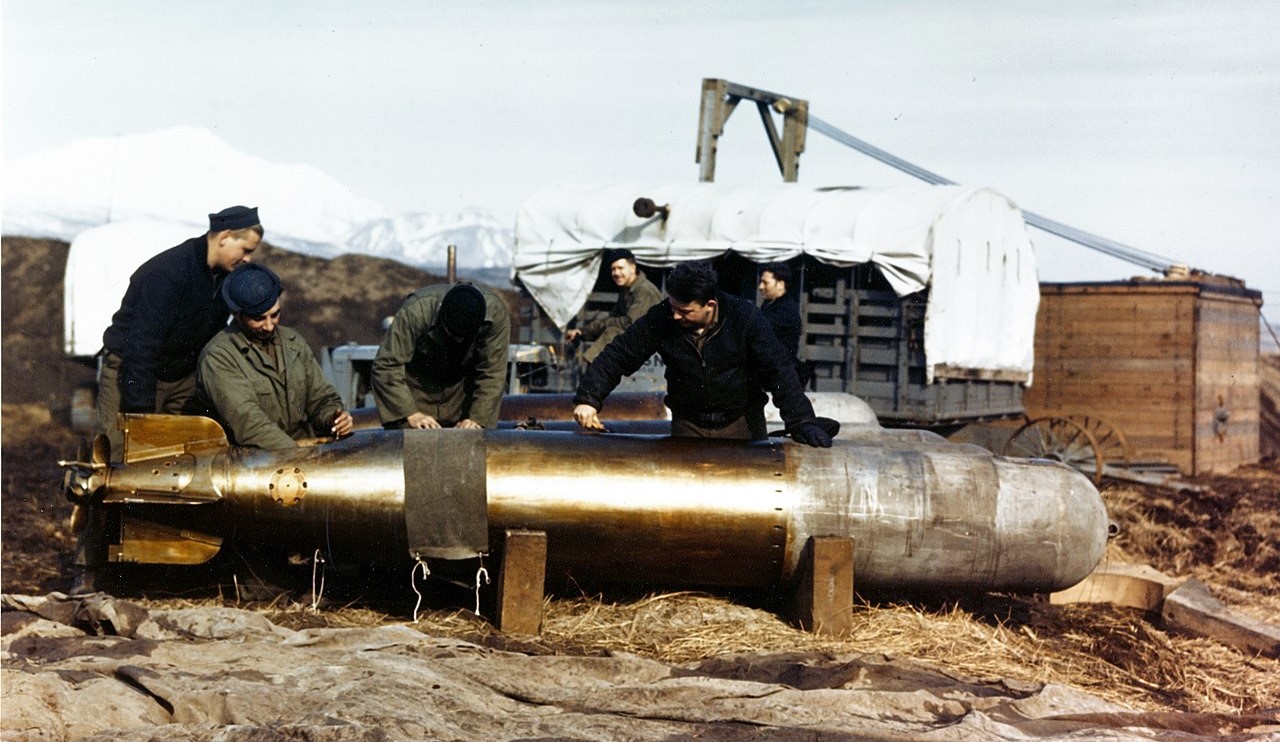
A Mk 13 torpedo undergoing maintenance
The outlier in how they used torpedoes was the Americans, who tended to do things slightly different from everyone else. Also, my sourcing on their practice is far better than I have for any other power, so they get their own post. The US Mk 13 aerial torpedo was distinguished in a number of ways. Most notably, it was relatively short and fat, 22.4" instead of the 17.7" that was standard in the rest of the world. This configuration was adopted as it was thought that a longer torpedo would be a serious constraint on the performance of future torpedo bombers.1 Also unusual was the range/speed combination, which was initially 6,000 yards at 30 kts, although this was later altered to 4,000 yards and 33.5 kts,2 still leaving it substantially slower and longer-ranged than was typical for an aerial torpedo.3 It also lacked the gyro-angling feature that most navies fitted their torpedoes with, which allowed the pilot to set a course different from the airplane's before the torpedo was dropped which it would then turn to after entering the water.4
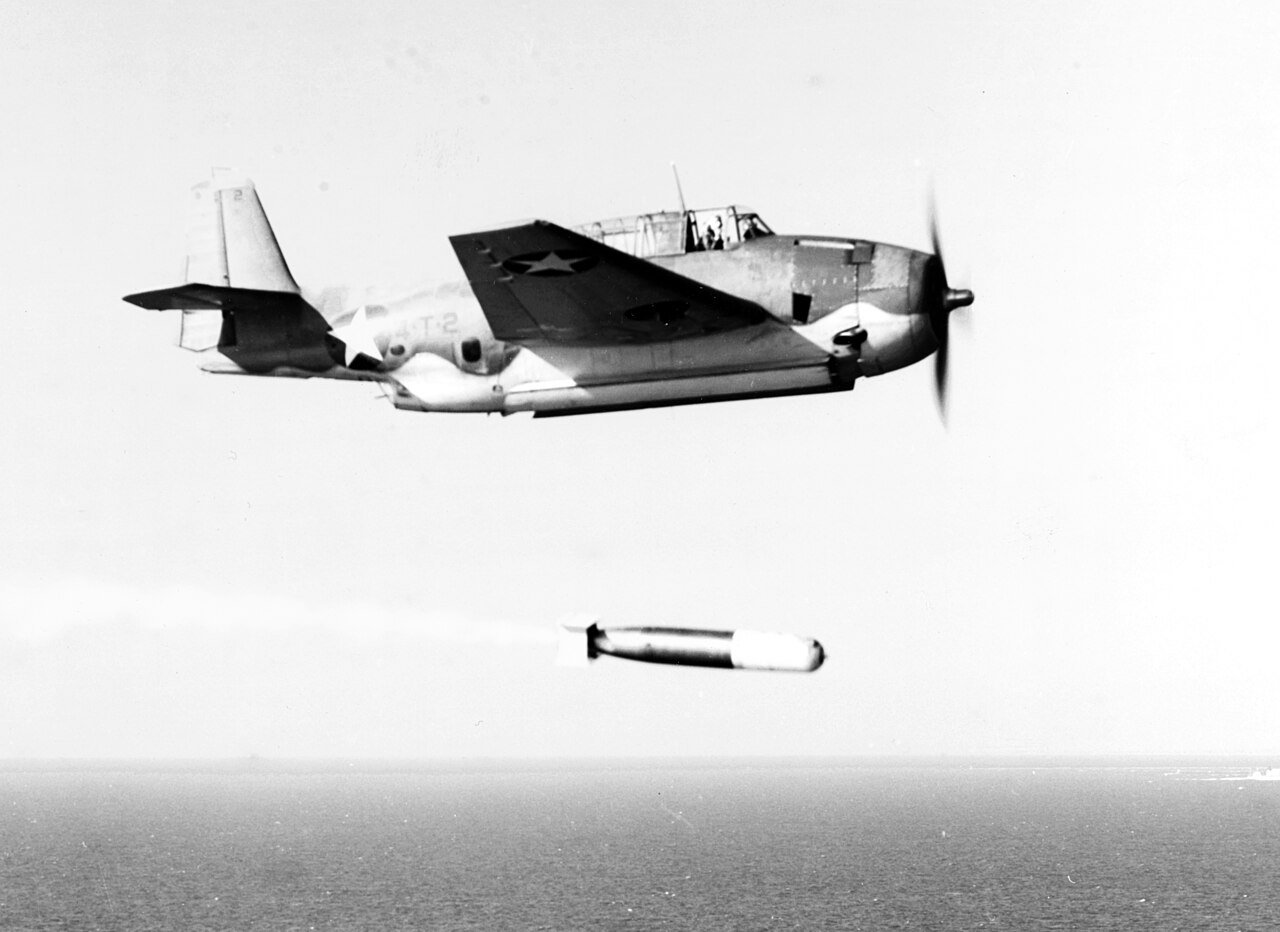
A TBF drops a Mk 13 without the trip valve, as shown by the trail behind the torpedo, and an early wooden tail
In the opening months of the war, the Mk 13 proved to be horribly unreliable,5 Some of the issues were solved by the fitting of an air tail, but the problems were serious enough that the Navy eventually brought in the National Defense Research Committee and CalTech to conduct a massive test campaign to figure out the solution. They made a number of changes,6 adding a ring to the weapon's tail to stabilize it on water entry, greatly reducing problems with hooking and diving too deep, and fitting a wooden drag ring to the nose of the weapon. This fitting, also known as the "pickle barrel", helped slow the weapon while it was still in the air and cushion its impact with the water, and is frequently credited with improving stability in the air, too. Another modification was to add a trip valve to the igniter, so the turbine ran cold until it entered the water, preventing it from overheating and overspeeding in the air. And as engines had reached the point where non-specialist aircraft could reliably carry torpedoes, other aircraft were qualified to carry the Mk 13, such as the SB2C Helldiver, normally a dive bomber, the F7F Tigercat fighter, and the ultimate result of the merger of torpedo and dive bombers, the legendary AD Skyraider, although none were actually used as torpedo bombers during WWII.
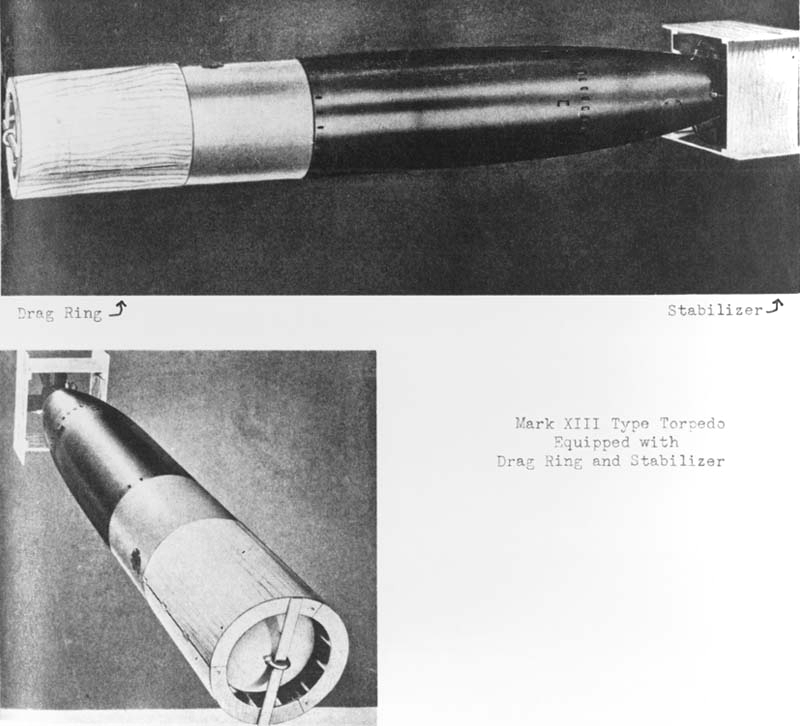
These upgrades reached the fleet just in time for use during Leyte Gulf, and the net result was that allowable drop conditions rose from 200' and 200 kts in 1942 to 2000' and 400 kts in 1945. Faster and higher drops also had an effect on the relative speed of torpedo and target, as the torpedo flew a significant distance through the air. The average speed of a Mk 13 dropped 1,500 yards from the target at 200' and 200 kts was only 40 kts, but a drop at the same range from 275' and 350 kts showed an average of 120 kts. This greatly reduced the difficulty of hitting the target, almost removing the need for a torpedo director, although such performance depended heavily on the torpedo arming quickly after it entered the water and not going so deep that it passed under the target before it could regain its set depth. It was in this form that the Mk 13 scored its greatest successes, sinking Yamato and Musashi. It was later to be the last straight-running aerial torpedo used in combat, when Skyriaders dropped it against the Hwacheon Dam in 1951.
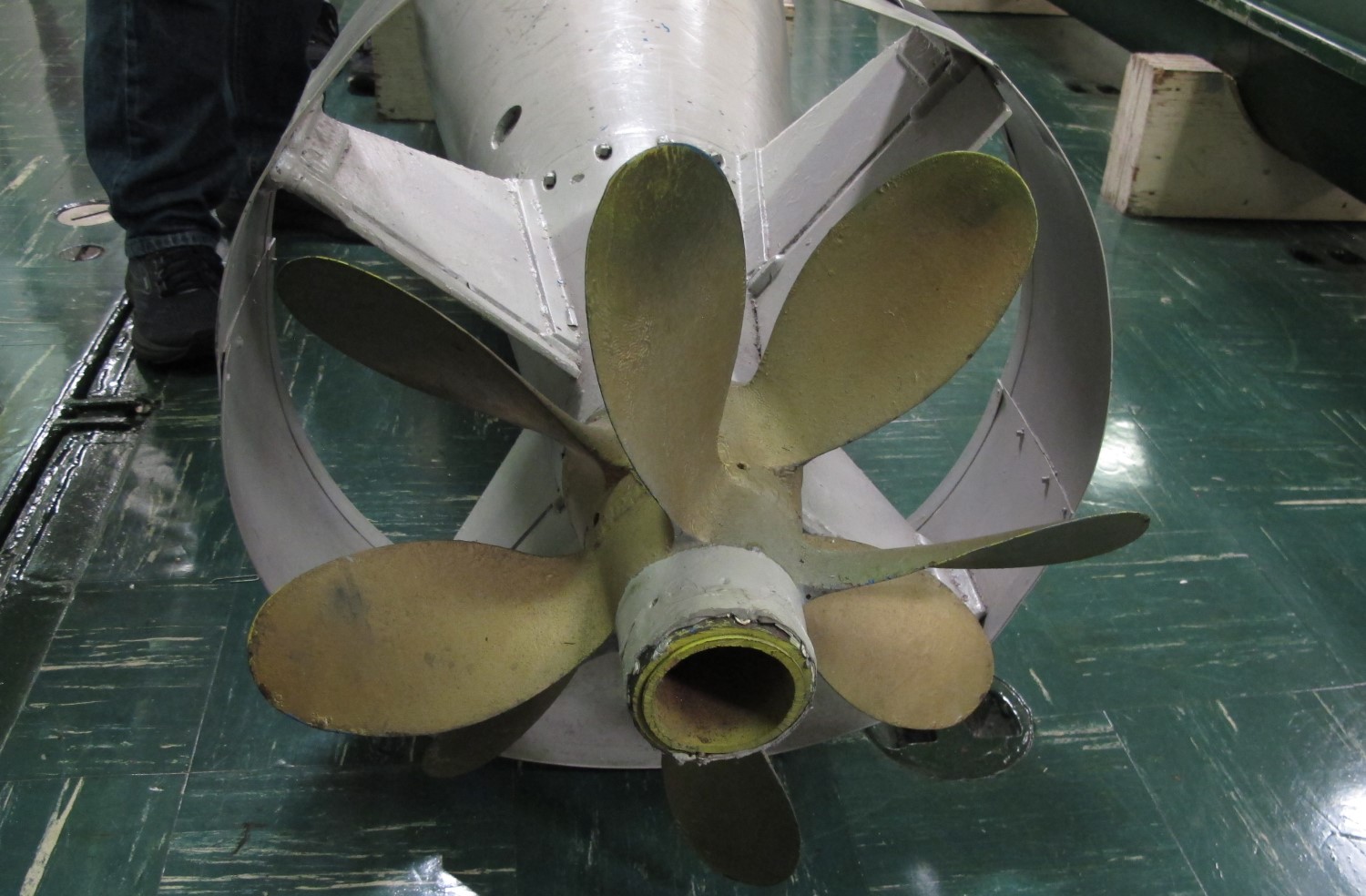
The ring tail of a Mk 13 aboard Hornet
One last torpedo variant that deserves mention7 is the Italian Motobomba, a unique circling torpedo that saw some action in the Mediterranean. The basic concept was simple enough. The weapon would be dropped from low altitude, and descend into the water under a parachute, then spiral outward in hopes of hitting an enemy ship. As it used an electric motor, the telltale bubble trail of a conventional torpedo was absent, although the lack of any depth control mechanism meant it was often visible when it broached, but there was a decent chance that it would impact any vessel that passed nearby within the hour or so its battery lasted, although it wasn't particularly fast, with speed starting at 13.5 kts and falling off steadily as the battery ran down.8 There were two different versions, weighing 280 and 350 kg, and even the larger one had a warhead of only 265 lb, making it dubious against most warships. Operational details are unclear, beyond its unsuccessful use against the Pedestal convoy to Malta, although the Germans did like it enough to adopt it themselves.9
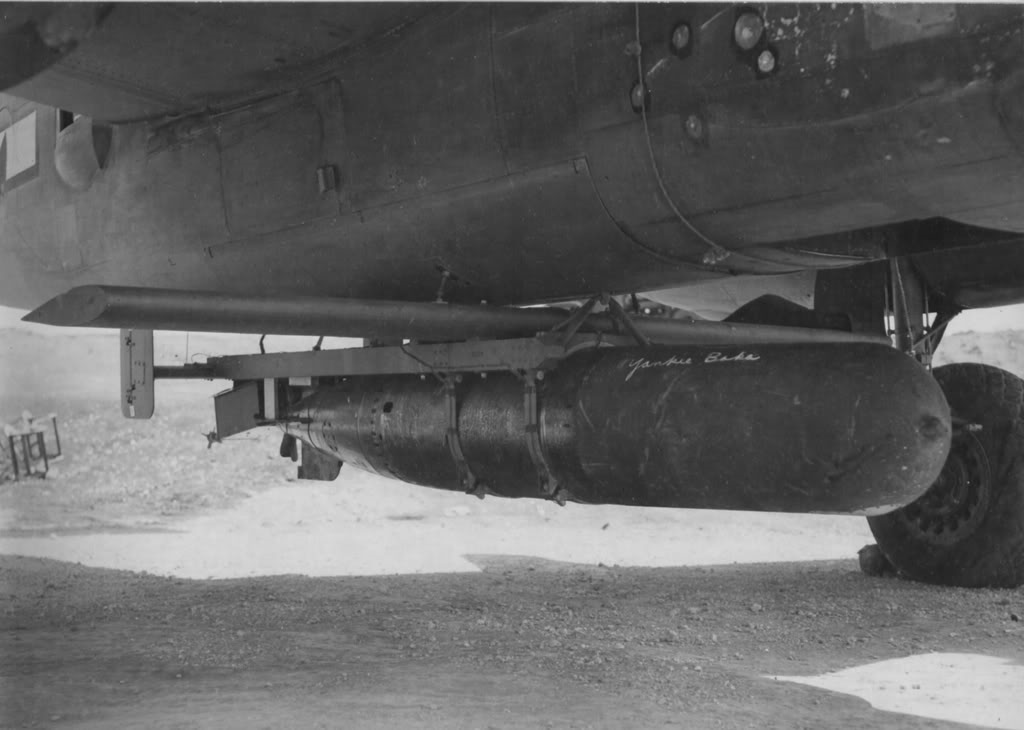
A GT-1 under the belly of a B-25
Postwar, the aerial torpedo quickly went out of fashion. Radar-directed AA guns made the sort of close approach required to use it far too hazardous, and the arrival of nuclear weapons and guided missiles meant that what anti-shipping duties remained in a world where the US and its allies had all of the major fleets didn't require torpedoes. There were some efforts to use guided gliding torpedoes to deal with this problem.10 Most of this work was done in the United States, where the Army Air Force produced the GT-1 glide torpedo, which used a circling system similar to the Motobomba to raise the chance of a hit from long range. The GT-1 was twice used operationally against ships in Japanese harbors just before the end of the war, although with uncertain results. The Navy subsequently developed the Petrel radar-guided torpedo cruise missile, tipped with the Mk 21 torpedo, an acoustic-homing version of the Mk 13. It remained in service until 1959, when it was finally retired.
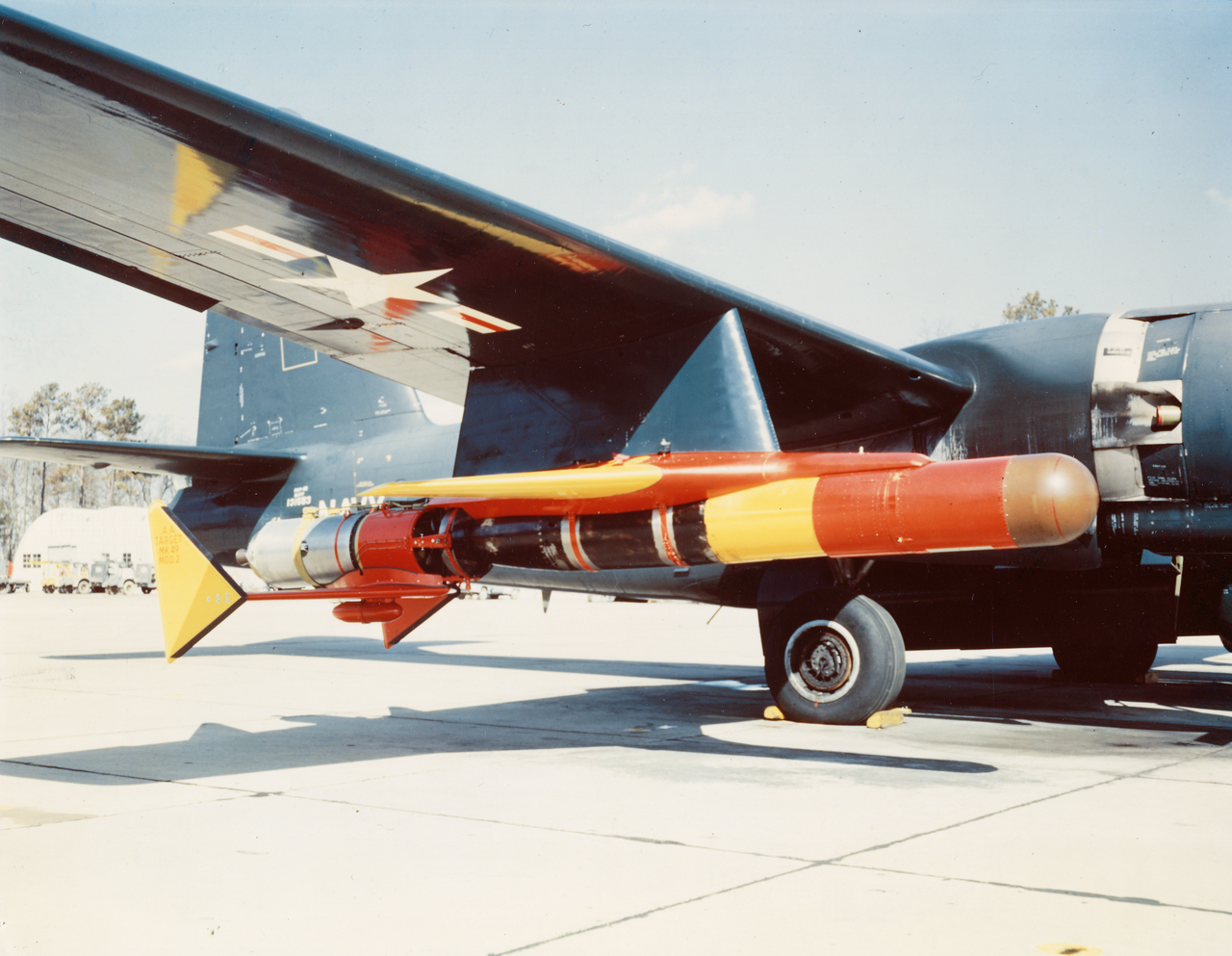
Petrel on the wing of a P2V Neptune
In this form, the torpedo outlived its major rival for the job of actually sinking ships, dive bombing, which had gone out of style immediately at the end of the war. We will take a look at that next time.
1 This was probably in part because the USN planned to carry its torpedoes internally, which also meant that they couldn't use the same wide air tails used by the British and Italians. Even on the Devastator, the tail was recessed. ⇑
2 As opposed to 1,500-2,500 yards and 40 kts for most other nations. ⇑
3 It's not clear why this was the case, as the benefits of speed are pretty obvious, and it may be due to the use of the Mk 13 aboard PT boats, which could probably benefit from the longer range. ⇑
4 This is slightly weird given that the USN was probably the leading proponent of gyro-angling for ship and surface torpedoes. ⇑
5 Note that this was not related to the more famous issues that plagued the Mk 14 submarine torpedo's detonator. In fact, it appears that the two weapons shared the same inertia pistol, but the Mk 13 was slower enough to allow the firing pin to function properly. BuOrd managed to screw up the Mk 13 separately. ⇑
6 And looked at a few ideas that didn't get implemented, like a retro-rocket setup to slow the torpedo down before water entry. ⇑
7 Because this series is on weapons used against surface ships, the US Mk 24 FIDO homing torpedo doesn't really fit, but does deserve a footnote. ⇑
8 Yes, the Wiki article at time of writing says 15-30 minutes at 40 kts. It is accurately reporting what the book it cites says, but the book is obviously wrong. Much larger submarine-launched electric torpedoes of the era struggled to reach 5 nm at 30 kts, and the same book says it had a 3.5 hp engine, which is clearly not enough for 40 kts. ⇑
9 Two notes. First, the wiki article gives it credit for the attack on Bari that released mustard gas carried by one of the ships. I have looked into this, and it appears to be false. None of the sources focused on Bari mention torpedo damage at all, and a book on the incident is very clear that the Germans were using conventional bombs. Second, the Italians also made use of oscillating mines, which would be dropped in front of an enemy force and float up and down, and these are sometimes confused with the Motobomba in sources. But they weren't torpedoes, and details are sketchy. ⇑
10 This is a concept that goes back much further than you might think. The Germans tried to develop a wire-guided gliding torpedo for use from Zeppelins in WWI, but British countermeasures made this far too hazardous to use. ⇑

Comments
(Warning: most of this is guesses.)
One potential problem with gyro angling air-dropped torpedoes is that having the rudder non-straight at water entry might add to the previously discussed problems. Did the nations that did have it actually use it, or was it mostly there because they were using standard torpedo parts and removing it would have been work?
And presumably gyro angle (if you had it) and depth had to be set before takeoff like other air-dropped weapons? Given the general state of datalink technology, it wouldn't be too implausible to have one that could be set in flight, but it seems unlikely that the US would be the only one to not have that.
PT boats didn't switch to the Mk13 until 1943, so it seems unlikely that they're the reason for its long range.
The rudder could be straight at water entry with it turning after being dropped, that would fix the problem assuming it exists.
But setting it up in the air may be difficult if a crew member can't access the weapon.
@muddywaters
Angling was considered a fairly serious and specific requirement by at least the Germans and the British, based on what I read, not just using standard parts. Not sure if it was ever actually used operationally. Depth was set before takeoff, but I'd assume gyro angle was set in flight somehow. Sources were not clear.
Good catch.
Gyro angle that has to be set before takeoff is plausibly better than none at all - you've probably thought about the best airplane approach direction(s) and the best torpedo course(s) (both relative to the target's course) in advance anyway, so can pre-set the angle between them.
Though on further thought, it wouldn't be that hard to make it settable in flight, as the typical layout of one torpedo directly under the crew compartment allows running basically the same mechanical shaft system as destroyer tubes use through the floor.
And presumably the better chance of hitting from a high/fast drop is because the shorter time to impact gives the target less time to move? (Either because it dodged after you dropped, or because you wrongly estimated its initial motion.)
The importance of a short time to impact is probably why torpedoes can't use the normal way to avoid breaking when air-dropped i.e. a parachute. (The Motobomba being an exception because while mechanically a torpedo, it's tactically closer to a mine, i.e. only likely to hit (rather than scare off) unaware targets.)
If anything, a significant time in the air makes it more complicated to aim - the simple velocity-triangle torpedo director (torpedo velocity vector - target velocity vector = line of sight, no range information required) no longer works, as the torpedo's average speed now depends on range, and it becomes more similar to aiming a bomb. (But still easier than hitting with an actual bomb, as a broadside-on torpedo hits when dropped anywhere in a diagonal strip about as wide as the target's length, while a bomb has to hit its width.) I don't know how they actually were aimed.
All
There was a discussion on this site some years ago of WW1 naval gunnery which I can't now find. I am looking for information that will help me to estimate the AP capability of WW1 warship guns. I have the usual books on this but what I need is some sort of effect at range table. I will create my own if need be but if anyone knows of where this might have already been done I'd be most grateful...
@muddywaters
I didn't want to get into torpedo directors because my sourcing on them wasn't great, and it was less interesting than the mechanics of torpedoes. As for faster drops making range errors matter more, that's true, but said range error is going to translate primarily into the torpedo arriving early/late at the aimpoint, which in turn will mean it hits farther forward/aft than intended, and you'd need a pretty big error to completely miss against a high-value target, which is the kind you are most likely to use torpedoes against anyway.
Re parachutes, those were investigated, and I believe the wooden tail/drag ring was adopted in preference to one, although I remain confused as to how the drag ring improved stability, as my sources keep insisting it did.
@John R
Check Navweaps. It should have those tables for most guns, and if not, you can work them out from the stuff Nathan Okun provided them.
Wiki links an original training video which apparently does describe the aiming process, but I get an error when I try to play that video.
@John R: you might be thinking of this and/or this. And yes, Navweaps often has penetration estimates. If you have more questions/comments not relating to an article, we have open threads.
@ muddywaters
From a pure math standpoint to find the precise answer yes, but practically it seems like the increased average projectile speed makes the solution less sensitive to other factors.
I think the intuition is that for a horizontal trajectory where the projectile hits the first thing in its path (vs a lobbed trajectory like a bomb or artillery, where you need azimuth and range to be correct) increasing projectile speed makes both range and leading the target less critical. Like, in the limit where you have a laser the only thing that matters is azimuth, with zero lead or range sensitivity because it instantly sweeps that azimuth. On the other hand if the projectile has say a ten knot advantage over the target, it needs to be accurate in azimuth and in range so that it can be in the right spot at the right time.
Also, it makes maneuvering by the target less meaningful. Per the numbers bean posted, at 1,500 yards the time to impact goes from 68 seconds to 22 seconds. If the target is doing 20 knots, it can only move 740’, rather than 2,300’.
I think we're closer to agreeing than it sounds like. In particular, I agree that a high/fast drop gives more chance of hitting than a low/slow one, because it gives the target less time to dodge.
(For drops from ranges you can actually get to. The theoretical shortest drop-to-impact time is a low drop at the torpedo's minimum arming range, but that's not a good idea on a real enemy because they'll probably shoot you before you get that close.)
The strip of drop points that hits is the same width for all drop heights/speeds. For a low drop it points directly at the target; for a high drop, it's shifted sideways by the in-air portion.
Also agreed that given that you're aiming for a ~250m wide strip ~1500m from the target, relatively crude approximations might well be good enough.